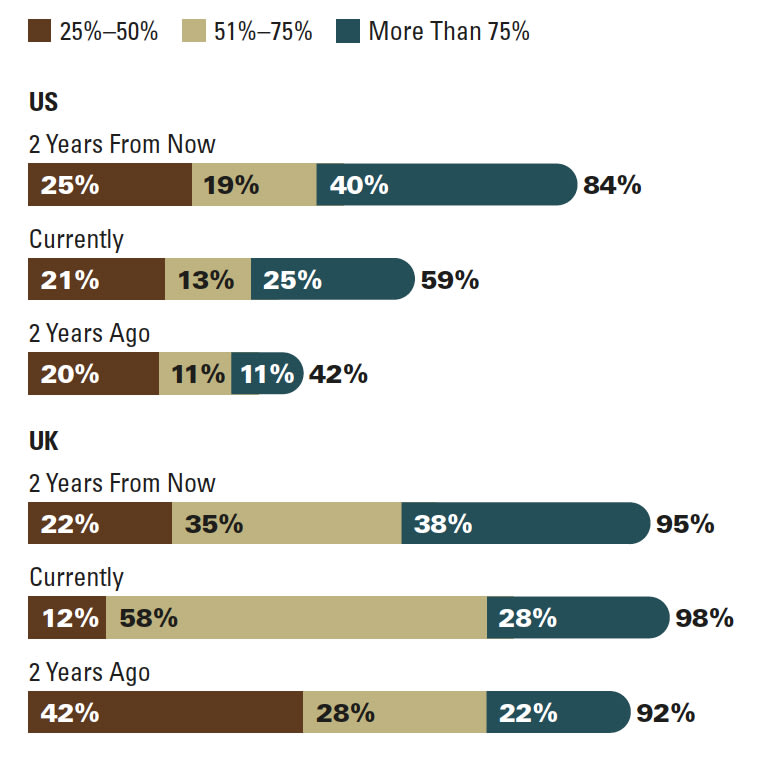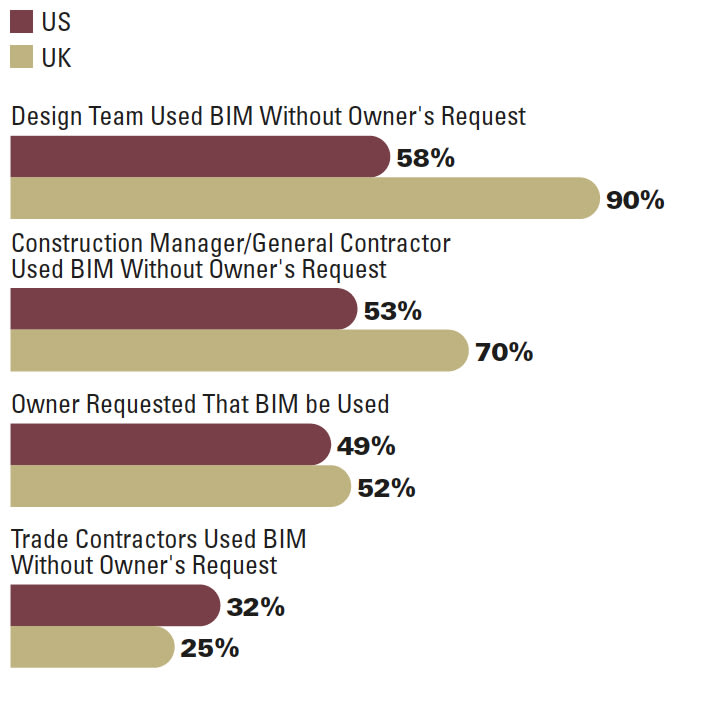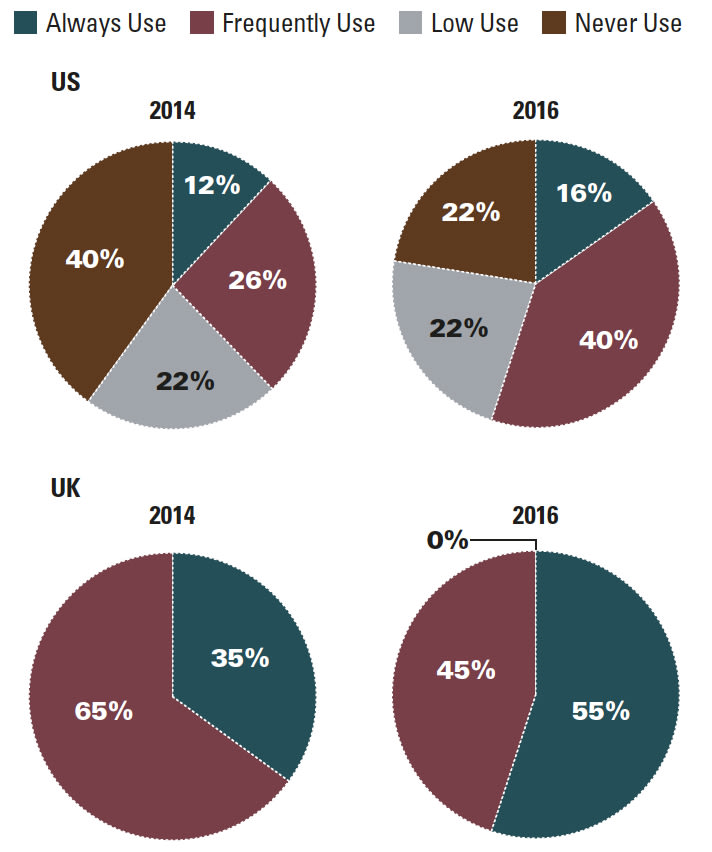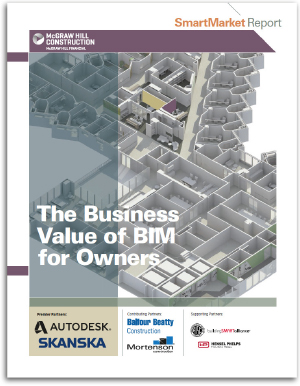Digital modelling is now firmly-established in the UK industry: 98% of clients in a new McGraw Hill survey said they used BIM for some of their projects, and 86% used it in more than a quarter. In two years’ time 38% said they would use a model in more than three-quarters of projects.
In the US, by contrast, only 59% of clients use BIM now, although there is an expectation that this will grow to 84% by 2016. What’s more, 88% of UK clients are formally measuring the impact of BIM, but only 18% of their American counterparts are doing the same.
These are some of the findings of a report by McGraw-Hill called The Business Value of BIM for Owners, sponsored by Skanska and Autodesk.
The report tracks a 10-year journey for UK clients. It shows they’ve moved from indifference to BIM to being activists who demand that their project teams adopt it, closely monitor its impact and look for ways to make use of the BIM model post-handover.
Proportion of BIM usage (moderate, high, very high usage)

Source: McGraw Hill Construction
In the past, the most common trigger for owners’ engagement with BIM in the UK seems to have been through proselytising by designers (90% of those surveyed). As this group tends to be the one that clients have most contact with this is unsurprising, although 70% also said the construction manager was using a model as well.
On the other hand, clients don’t tend to do anything with the model themselves: only 20% own the necessary software to edit files and, more surprisingly, only 60% are able to even open them, However, that is put into perspective by the finding that just 15% of American clients can do the same.
Generally, owners prefer to rely on specialised BIM consultants to look at the model for them, and again this is much more common in the UK than the US. Here, 65% of clients make frequent use of BIM consultants in the UK compared with 26% in America.
This lack of direct involvement, even among clients that use BIM for more than three-quarters of their projects, is partly because they lack trained staff (the most common reason in the US) and partly because they don’t want to spend the money on the software (the most common reason in the UK).
Initial interaction with BIM

Source: McGraw Hill Construction
That said, there are some groups of clients that do make enthusiastic use of BIM: for example, those in the US healthcare sector seem to have unanimously adopted it.
Although BIM gained traction as a bottom-up process led by designers, its success after a certain point seems to rely on a top-down intervention by the state. Here, the report concludes that the UK government’s decision to make 3D BIM compulsory on its schemes by 2016 has had a galvanising effect on the UK – as it also has had in other regions that have adopted similar policies, such as Singapore, South Korea and Scandinavia.
Two-thirds of UK clients said the 2016 deadline had changed their way of thinking, with 76% being inspired to initiate a BIM-controlled project and 66% encouraged to add BIM resources to their organisation.
One contractor canvassed for the report commented that large private sector clients and many public sector ones were demanding models, and the opinion formers within the industry were becoming more vocal about their desire to “lead the world in BIM”.
The report looks at one instance of how this is working in the UK’s prison and court building programme, which is run by the Ministry of Justice (MoJ). This appears to illustrate the importance of client activism and leadership: the MoJ cut the number of designers and contractors to a squad of about two dozen, then worked to “coach” and support this core group to build up a sense of cohesion between them. The next planned step is to bring in laser scanning and BIM-driven prefabrication.
Owners’ use of BIM consultants

Source: McGraw Hill Construction
Terry Stocks, the man in charge of the MoJ’s procurement strategy, says “our experience has been that BIM hasn’t cost more” and in terms of the percentage of a project’s budget that ends up in the finished product “we’re about 25% more efficient that we were in 2009”.
However, even with this degree of scrutiny by the client, there hasn’t been a noticeable reduction in the cost. Stocks says: “We’ve been using BIM for about two years and everyone is starting to realise that it reduces risk at the front end of a project. At the moment, they’re just at the cusp where they’ve done a couple of projects, they’ve been able to derisk the contrition, but they haven’t been brave enough to put it in their price. That’s something, as an intelligent client, you just have to live with; otherwise, you’re not going to get them on the journey.”
The findings also reveal that UK owners are increasingly using BIM for facilities management. The survey found that 78% of owners in the UK attached a high value to the use of BIM in FM, as opposed to 18% of owners in the US, and by 2019, 98% of those surveyed expected to be using BIM for their FM (compared with 52% of clients in the US).
This points to a revolution in the FM industry – already, 94% of UK owners say they frequently get a model along with the completed building, and a third say they always get them.
But the report also found that owners face significant challenges when they try to integrate a model into their existing FM systems: there is the omnipresent problem of getting different software languages to communicate, and there is the equally common issue of adapting a working culture to fit in with BIM, rather than trying to adapt the BIM to fit in with the culture – the first impulse of many organisations.
















